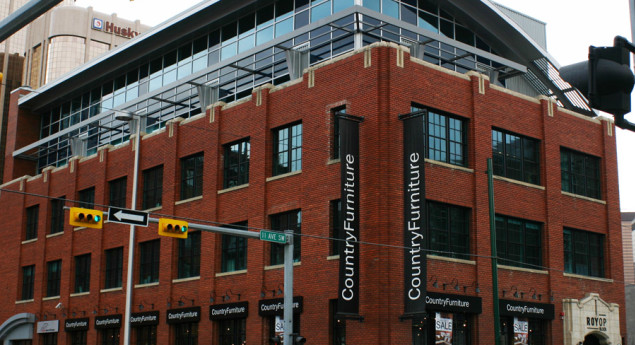Heritage Character Statement
A Utilitarian Brick Warehouse Building Executed In Edwardian Commercial Style Featuring; Formal Tyndall Stone Entrance, Symmetrically Ordered Window Pattern, Engaged Pilasters, Parapet With Stone Crenellations, Stone String Course, And Stone Plinth. Alterations In 2005 Include; All Exterior Windows Replaced, Major Roof Top Addition, And New Exit Stair.
Summary History
The Royop Block Is A Five-Storey Building In Calgary's Historic Warehouse District That Lies Within The Beltline Communities Of Victoria And Connaught. It Is Comprised Of The Sherwin-Williams Company Warehouse, A Three-Storey Brick Building Constructed In 1913, And A Two-Storey Addition Built Atop The Historic Structure In 2005.
This Property Lies Within Calgary's Original Town Limits As They Were Established In 1884. The First Building On This Site Was A 1905 Residence That Was Notable As The Home Of Ernest L. Richardson, The Longtime Manager Of The Calgary Exhibition And Later Of The Calgary Exhibition And Stampede.
In 1913, The Sherwin-Williams Company Of Canada Ltd. Bought The Property As A Site For Its Paint And Varnish Warehouse. The Contractor Was The Carter-Halls-Aldinger Company Ltd., A Winnipeg-Based Company That Built Many Significant Buildings In Calgary Including The Hudson's Bay Company, Leeson & Lineham Building, Merchants Bank Building, And The 1927 Addition To The Palliser Hotel.
Calgary's Warehouse District Flourished In The Dozen Years After The Calgary Board Of Trade Negotiated A Preferred Freight Rate In 1902. Spur Lines Directed Freight Cars From The Canadian Pacific Railway Right-Of-Way To The Back Lanes Behind 8, 9, 10, 11, And 12 Avenues. They Stretched From What Is Now 13 Avenue S.w. To 4 Street S.e. Dozens Of Warehouses Served Hundreds Of Companies, And Warehousing And Jobbing Became A Major Component Of The City's Economy. The Building Represented A Massive Capital Investment By Canadian, American, And British Concerns.
The Sherwin-Williams Company Of Canada Ltd. Is A Canadian Subsidiary Of The Sherwin-Williams Company, Which Is Itself A Successor To The Original Sherwin-Williams & Co. That Henry Sherwin And Edward Williams Established In Cleveland, Ohio, In 1866. Construction Of The Calgary Warehouse Coincided With Sherwin-Williams' Role In The Construction And Finishing Of The Palliser Hotel, Which Was Completed In 1914. The Elaborate Entrance Of The Warehouse Strongly Suggests That The Building Was Designed For A Display And/or Sales Function As Well As Warehousing. The Building Was Damaged By Fire In 1943, And It Was Renovated In 1945. The Building Remained Sherwin-Williams' Calgary Headquarters Until 1965.
From 1972-82, The Building Was Owned And Occupied By Mcarthur Furniture (Alta.) Ltd. This Was One Of Several Warehouses That Became A Furniture Store In The 1960's.
Earn 10 points!
Photo: Image from beltline.ca (http://beltline.ca/media/Buildings_Royop%20(2).jpg)









